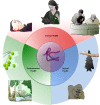One Health: Addressing Global Challenges at the Nexus of Human, Animal, and Environmental Health
- PMID: 27631500
- PMCID: PMC5025119
- DOI: 10.1371/journal.ppat.1005731
One Health: Addressing Global Challenges at the Nexus of Human, Animal, and Environmental Health
Conflict of interest statement
The authors have declared that no competing interests exist.
Figures


References
-
- Wood C.L., et al., Does biodiversity protect humans against infectious disease? Ecology, 2014. 95(4): p. 817–32. - PubMed
-
- Macready, P. An ambivalent Luddite at a technological feast. Designfax, 1999. August.
Publication types
MeSH terms
LinkOut - more resources
Full Text Sources
Other Literature Sources
Medical

